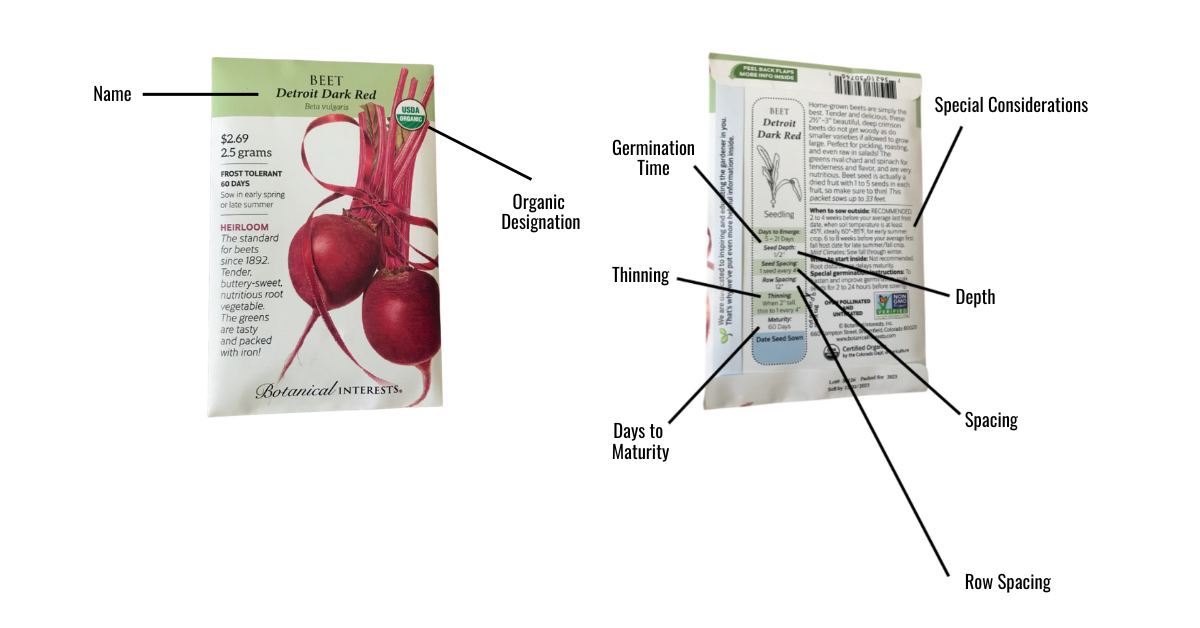Seed packets may seem like simple envelopes filled with potential, but they hold a wealth of information crucial to your gardening success. Understanding how to read a seed packet empowers you to plant at the right time and provide the care needed for your seeds to flourish into healthy plants. They’re the perfect ‘how-to’ guide for your seed variety!
The front of your seed packet will tell you your variety name, its Latin name, and whether or not it is organic (meaning non-GMO seeds). There’s often a picture of the variety as well so you have an idea of what you’re growing! The back of your seed packet is usually where you’ll find all the details, including more information about the variety.
Other things you’ll want to look out for:
- Germination time: The number of days or weeks it takes for seeds to emerge from the soil. This information helps you plan your planting schedule and manage your expectations for when you’ll see sprouts emerging from the soil.
- Thinning: Provides the recommended distance between growing seedlings to prevent overcrowding. Pull out extra seedlings to create more space for your seedlings to thrive.
- Days To Maturity: The time it takes for a plant to produce harvestable fruits or flowers. Knowing the days to maturity helps you plan your garden layout and anticipate when you can expect to start harvesting.
- Special Considerations: Some seed packets include additional information or special considerations for growing certain plants. This may include tips for managing pests and diseases, providing support structures like trellises, or other unique requirements.
- Depth: This indicates how deep to sow the seeds in the soil. It’s crucial to follow this guideline to ensure proper germination.
- Spacing: Provides the recommended distance between seeds or seedlings when planting. Proper spacing prevents overcrowding and allows plants to access adequate sunlight, water, and nutrients.
- Row Spacing: Indicates the distance between rows when planting multiple rows of seeds. Proper row spacing promotes air circulation and makes it easier to tend to your plants.

Other information your packet is likely to contain:
Sunlight Requirements:
Specifies the amount of sunlight needed for optimal growth. Whether a plant requires full sun, partial sun, or shade influences where you should place it in your garden to ensure it receives the appropriate amount of light.
Watering and Fertilizing Instructions:
Provides general guidelines for watering frequency and fertilization requirements. While individual plants may have specific needs, these instructions offer a starting point for maintaining proper moisture levels and nutrient supply.
Tips for Success:
- Read the entire seed packet carefully before planting to understand the specific needs of each plant.
- Keep track of planting dates, germination times, and days to maturity to help you stay organized and plan your gardening tasks.
- Monitor your plants regularly and adjust care practices as needed based on their growth and development.
- Don’t hesitate to seek additional information from gardening books, online resources, or local gardening experts if you encounter challenges or have questions.
- By mastering the art of reading seed packets, you’ll be well-equipped to plant your garden with confidence and nurture your seeds into thriving plants. Remember, each seed holds the promise of a bountiful harvest or beautiful blooms, so take the time to give them the care they deserve.
Happy gardening!

